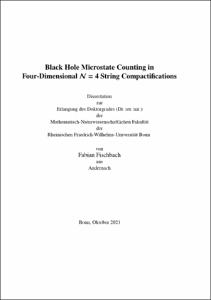Fischbach, Fabian: Black Hole Microstate Counting in Four-Dimensional N = 4 String Compactifications. - Bonn, 2022. - Dissertation, Rheinische Friedrich-Wilhelms-Universität Bonn.
Online-Ausgabe in bonndoc: https://nbn-resolving.org/urn:nbn:de:hbz:5-65112
Online-Ausgabe in bonndoc: https://nbn-resolving.org/urn:nbn:de:hbz:5-65112
@phdthesis{handle:20.500.11811/9554,
urn: https://nbn-resolving.org/urn:nbn:de:hbz:5-65112,
author = {{Fabian Fischbach}},
title = {Black Hole Microstate Counting in Four-Dimensional N = 4 String Compactifications},
school = {Rheinische Friedrich-Wilhelms-Universität Bonn},
year = 2022,
month = jan,
note = {This thesis presents research on the spectrum of supersymmetric Bogomol'nyi-Prasad-Sommerfield (BPS) states in a specific superstring compactification with N=4-extended supersymmetry in four dimensions, known as the Z2 Chaudhuri-Hockney-Lykken (CHL) model. Specifically, partition functions for quarter-BPS states in various charge sectors are derived and tested by combining worldsheet aspects, string dualities and modularity properties and the results are discussed in the light of black hole microstate counting. After a brief and non-technical introduction to superstring theory and the problem of explaining the entropy of black holes, we introduce the specific string compactification with which we will work. Representations of the N=4 superalgebra are reviewed in view of BPS conditions before the central objects of our investigation, partition functions for quarter-BPS dyons in suitable electric-magnetic charge sectors of the theory, are introduced. These functions are identified in the chiral heterotic genus two orbifold partition function appropriate for the Z2 CHL model. We discuss parallels with electric half-BPS partition functions and show that the derived quarter-BPS partition functions satisfy all physical requirements from charge quantization, wall-crossing and S-duality by investigating the transformation properties and pole structure of the corresponding Siegel modular forms. An alternative determination of the partition functions by reverse engineering the constraints is also briefly discussed, as well as the compatibility of our results with those derived by other means in the physics literature. As the quarter-BPS states correspond to extremal dyonic black holes in the low-energy effective supergravity theory, their microscopic degeneracy and hence statistical entropy can be compared to a macroscopic black hole entropy computed using the entropy function formalism in the two-derivative supergravity approximation plus model-specific higher-derivative corrections to the latter. This connection is explored in particular by comparing large-charge expansions of the entropy. Lastly, our findings are compared to closely related conjectures in enumerative geometry, in particular Donaldson-Thomas partition functions for CHL Calabi-Yau threefold geometries that correspond to the N=4 compactification space of the dual type IIA theory.},
url = {https://hdl.handle.net/20.500.11811/9554}
}
urn: https://nbn-resolving.org/urn:nbn:de:hbz:5-65112,
author = {{Fabian Fischbach}},
title = {Black Hole Microstate Counting in Four-Dimensional N = 4 String Compactifications},
school = {Rheinische Friedrich-Wilhelms-Universität Bonn},
year = 2022,
month = jan,
note = {This thesis presents research on the spectrum of supersymmetric Bogomol'nyi-Prasad-Sommerfield (BPS) states in a specific superstring compactification with N=4-extended supersymmetry in four dimensions, known as the Z2 Chaudhuri-Hockney-Lykken (CHL) model. Specifically, partition functions for quarter-BPS states in various charge sectors are derived and tested by combining worldsheet aspects, string dualities and modularity properties and the results are discussed in the light of black hole microstate counting. After a brief and non-technical introduction to superstring theory and the problem of explaining the entropy of black holes, we introduce the specific string compactification with which we will work. Representations of the N=4 superalgebra are reviewed in view of BPS conditions before the central objects of our investigation, partition functions for quarter-BPS dyons in suitable electric-magnetic charge sectors of the theory, are introduced. These functions are identified in the chiral heterotic genus two orbifold partition function appropriate for the Z2 CHL model. We discuss parallels with electric half-BPS partition functions and show that the derived quarter-BPS partition functions satisfy all physical requirements from charge quantization, wall-crossing and S-duality by investigating the transformation properties and pole structure of the corresponding Siegel modular forms. An alternative determination of the partition functions by reverse engineering the constraints is also briefly discussed, as well as the compatibility of our results with those derived by other means in the physics literature. As the quarter-BPS states correspond to extremal dyonic black holes in the low-energy effective supergravity theory, their microscopic degeneracy and hence statistical entropy can be compared to a macroscopic black hole entropy computed using the entropy function formalism in the two-derivative supergravity approximation plus model-specific higher-derivative corrections to the latter. This connection is explored in particular by comparing large-charge expansions of the entropy. Lastly, our findings are compared to closely related conjectures in enumerative geometry, in particular Donaldson-Thomas partition functions for CHL Calabi-Yau threefold geometries that correspond to the N=4 compactification space of the dual type IIA theory.},
url = {https://hdl.handle.net/20.500.11811/9554}
}






